cruise control Oldsmobile Aurora 1998 Owner's Manuals
[x] Cancel search | Manufacturer: OLDSMOBILE, Model Year: 1998, Model line: Aurora, Model: Oldsmobile Aurora 1998Pages: 380, PDF Size: 19.75 MB
Page 100 of 380
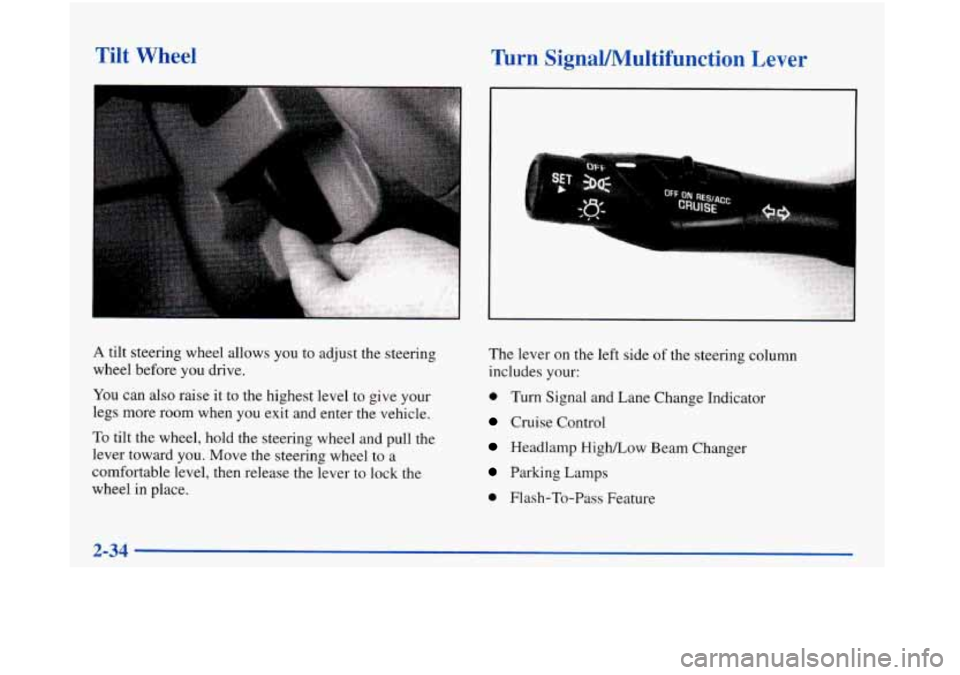
Tilt Wheel Turn SignaVMultifunction Lever
.. ::..,". .: ..:. s;r:
A tilt steering wheel allows you to adjust the steering
wheel before you drive.
You can also raise it to the highest level to give your
legs more room when you exit and enter the vehicle.
To tilt the wheel, hold the steering wheel and pull the
lever toward you. Move the steering wheel to a
comfortable level, then release the lever
to lock the
wheel in place. The
lever on the left side
of the steering column
includes your:
0 Turn Signal and Lane Change Indicator
Cruise Control
Headlamp High/Low Beam Changer
Parking Lamps
0 Flash-To-Pass Feature
2-34
Page 105 of 380

Windshield Washer Cruise Control
The
lever on the right side of your steering column also
controls your windshield washer. To spray washer fluid
on the windshield, pull the lever toward
you. The wipers
will clear the window and then either stop or return to
your preset speed. For more washer cycles, pull and
hold the lever.
If the fluid level in the windshield washer bottle is low,
the message LOW WASHER
FLUID will appear in the
Driver Information Center. See “Windshield Washer
Fluid” in the Index.
In freezing weather, don’t use your washer until
the windshield is warmed. Otherwise the washer
fluid can form ice on the windshield, blocking
your vision.
With cruise control, you can maintain a speed of about
25 mph (40 km/h) or more without keeping your foot
on the accelerator. This can really help on long trips.
Cruise control does not work at speeds below about
25 mph (40 ludh).
When you apply your brakes, the cruise control
shuts
off.
Cruise control can be dangerous where you
can’t drive safely at
a steady speed. So,
don’t use your cruise control on winding
roads or in heavy traffic.
slippery roads. On such roads, fast changes
in tire traction can cause needless wheel
spinning, and you could lose control. Don’t
use cruise control on slippery roads.
Cruise control can be dangerous on
Page 106 of 380
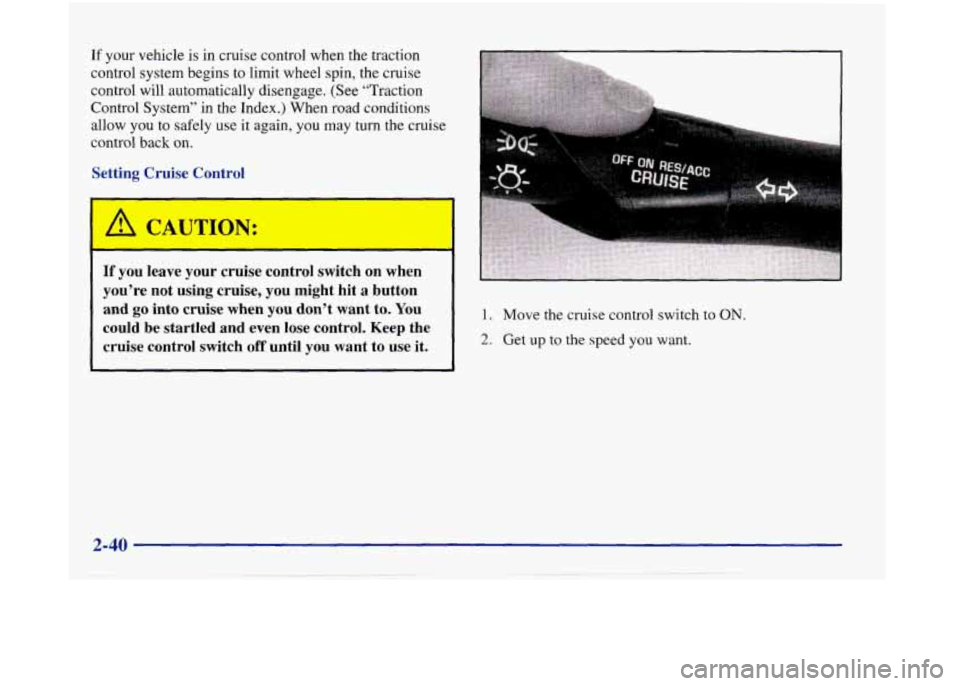
If your vehicle is in cruise control when the traction
control system begins to limit wheel spin, the cruise
control will automatically disengage. (See “Traction
Control System’’ in the Index.) When road conditions
allow you to safely use it again,
you may turn the cruise
control back on.
Setting se -1ntrol O---’
.. I
you’re not using cruise, you might hit a button
and
go into cruise when you don’t want to. You 1. Move the cruise control switch to ON.
could be startled and even lose control. Keep the
cruise control switch
off until you want to use it. 2. Get up to the speed you want.
2-40
Page 107 of 380
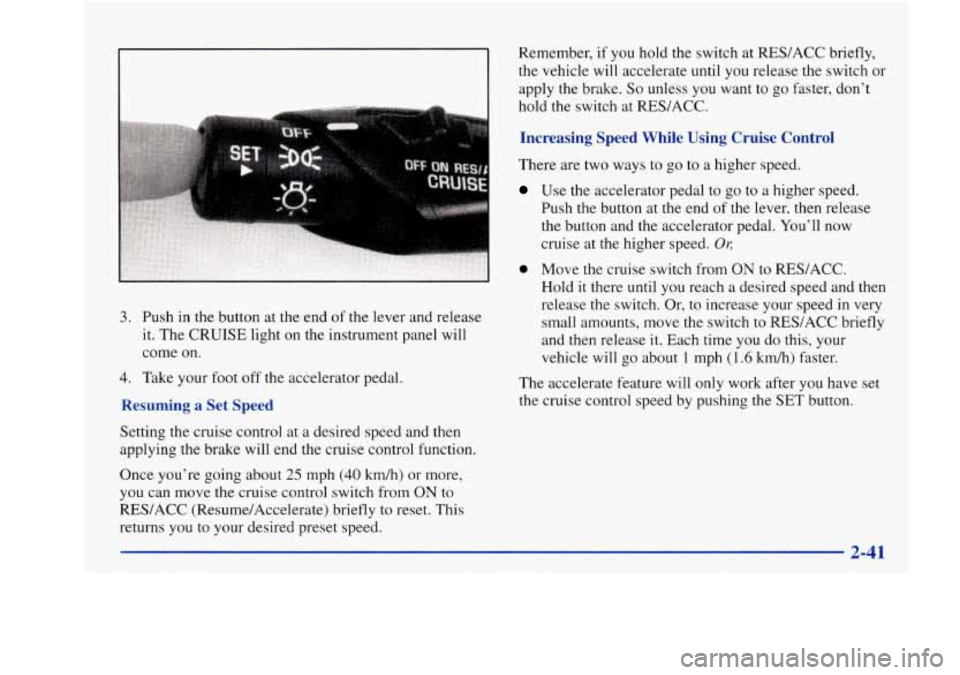
.... .. . .. . ..
3. Push in the button at the end of the lever and release
it.
The CRUISE light on the instrument panel will
come on.
4. Take your foot off the accelerator pedal.
Resuming a Set Speed
Setting the cruise control at a desired speed and then
applying the brake will end the cruise control function.
Once you’re going about
25 mph (40 km/h) or more,
you can move the cruise control switch from
ON to
RES/ACC (Resume/Accelerate) briefly to reset. This
returns you to your desired preset speed. Remember,
if you hold the switch at RES/ACC briefly,
the vehicle will accelerate until you release the switch or
apply the brake.
So unless you want to go faster, don’t
hold the switch at RES/ACC.
Increasing Speed While Using Cruise Control
There are two ways to go to a higher speed.
Use the accelerator pedal to go to a higher speed.
Push the button at the end of the lever, then release
the button and the accelerator pedal. You’ll now
cruise at the higher speed.
01;
0 Move the cruise switch from ON to RES/ACC.
Hold
it there until you reach a desired speed and then
release the switch. Or, to increase your speed in very
small amounts, move the switch to RES/ACC briefly
and then release it. Each time you do this, your
vehicle will
go about 1 mph (1.6 km/h) faster.
The accelerate feature will only work after you have set
the cruise control speed by pushing the SET button.
Page 108 of 380
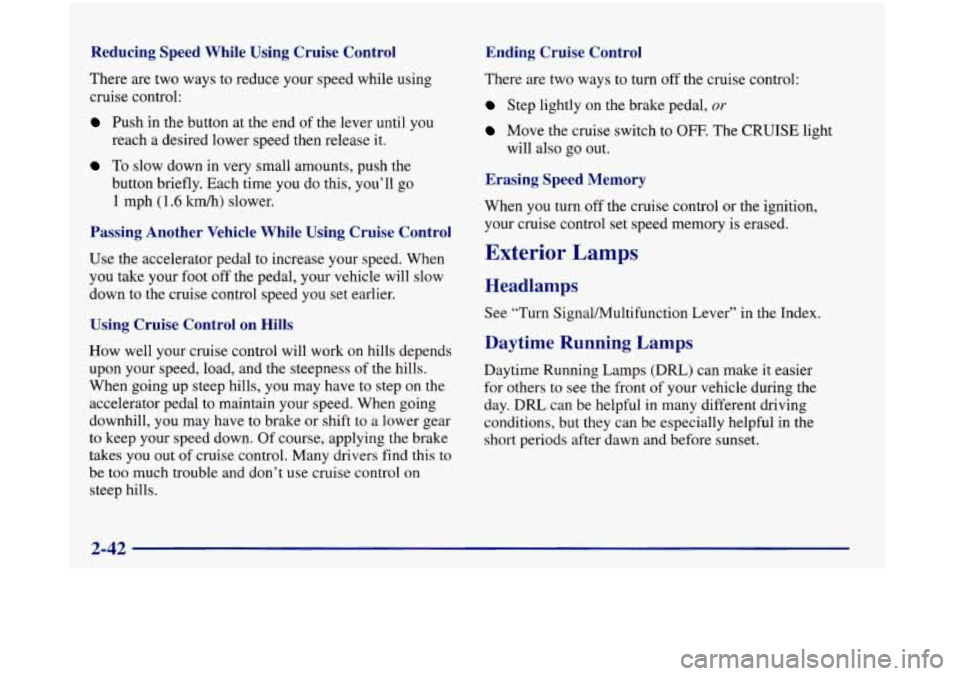
Reducing Speed While Using Cruise Control
There are two ways to reduce your speed while using
cruise control:
Push in the button at the end of the lever until you
reach a desired lower speed then release it.
To slow down in very small amounts, push the
button briefly. Each time you do this, you’ll go
1 mph (1.6 km/h) slower.
Passing Another Vehicle While Using Cruise Control
Use the accelerator pedal to increase your speed. When
you take your foot
off the pedal, your vehicle will slow
down to the cruise control speed
you set earlier.
Using Cruise Control on Hills
How well your cruise control will work on hills depends
upon your speed, load, and the steepness of the hills.
When going up steep hills, you may have to step on the
accelerator pedal to maintain your speed. When going
downhill, you may have to brake or shift to a lower gear
to keep your speed down. Of course, applying the brake
takes you out of cruise control. Many drivers find this to
be too much trouble and don’t
use cruise control on
steep hills.
Ending Cruise Control
There are two ways to turn off the cruise control:
Step lightly on the brake pedal, or
Move the cruise switch to OFF. The CRUISE light
will also go out.
Erasing Speed Memory
When you turn off the cruise control or the ignition,
your cruise control set speed memory is erased.
Exterior Lamps
Headlamps
See “Turn SignalMultifunction Lever” in the Index.
Daytime Running Lamps
Daytime Running Lamps (DRL) can make it easier
for others to see the front of your vehicle during the
day.
DRL can be helpful in many different driving
conditions, but they can be especially helpful in the
short periods after dawn and before sunset.
2-42
~
Page 187 of 380
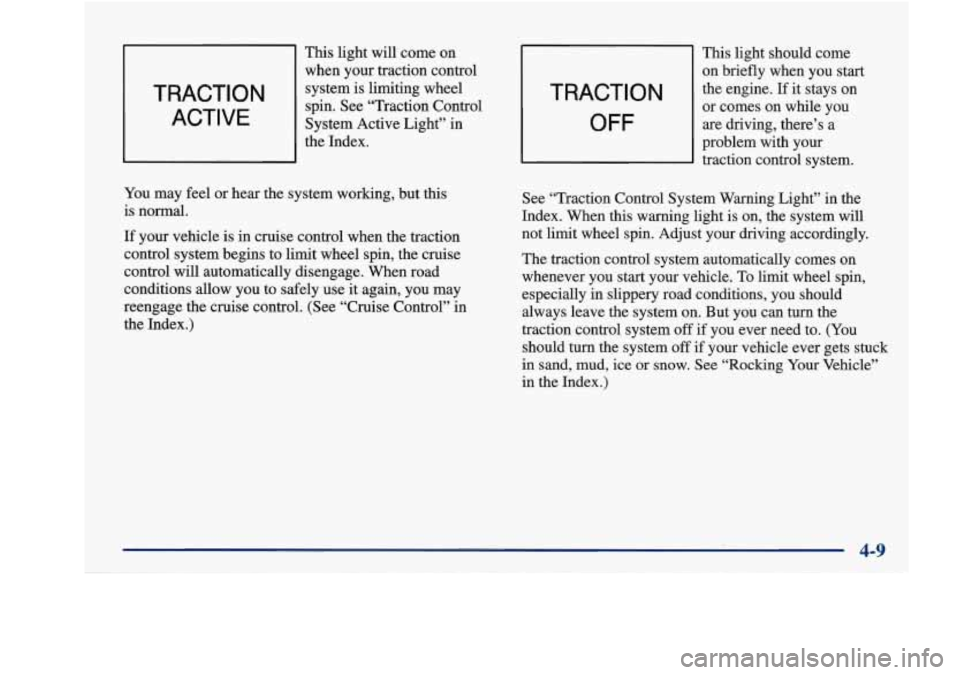
This light will come on
when your traction control
TRACTION
ACTIVE system is limiting wheel
spin. See “Traction Control
System Active Light” in
the Index.
You may
feel or hear the system working, but this
is normal.
If your vehicle is in cruise control when the traction
control system begins to limit wheel spin, the cruise
control will automatically disengage. When road conditions allow you to safely use it again, you may
reengage the cruise control. (See “Cruise Control” in the Index.)
TRACTION
OFF
This light should come
on briefly when you start
the engine.
If it stays on
or comes on while you
are drrving, there’s a
problem with your
traction control system.
See “Traction Control System Warning Light” in the
Index. When this warning light is on, the system will
not limit wheel spin. Adjust your driving accordingly.
The traction control system automatically comes on
whenever you start your vehicle. To limit wheel
spin,
especially in slippery road conditions, you should
always leave the system on. But you can turn the
traction control system
off if you ever need to. (You
should turn the system
off if your vehicle ever gets stuck
in sand, mud, ice or
snow. See “Rocking Your Vehicle”
in the Index.)
4-9
Page 315 of 380

Fuse Usage
1 Supplemental Inflatable Restraint (Air Bag)
2
3
4
5
6
7
Injectors
Anti-Lock Brake System
Left Exterior Lamps Turn Signal Lamps
Injectors Climate Controls
8 Right Exterior Lamps
9 Chime (Ignition l), Memory Set
10 Powertrain Control Module, VATS
PASS-Key@II
11 Auxiliary Power
12
13
14
15
16
Interior Lamps Shift Solenoids
Linear
EGR
Cruise Control
Perimeter Lights
Fuse
17 18
19
20
21 22
23
24
25
26 27
28
Usage
Driver Information Center
Converter Oxygen Sensors
Radio Open
Climate Control Relay
Fog Lamps
Windshield Wipers
Flat Pack Motor
TMNSS
Cigarette Lighter
Crank,
Air Bag Module
Climate Control Blower
6-63
Page 345 of 380
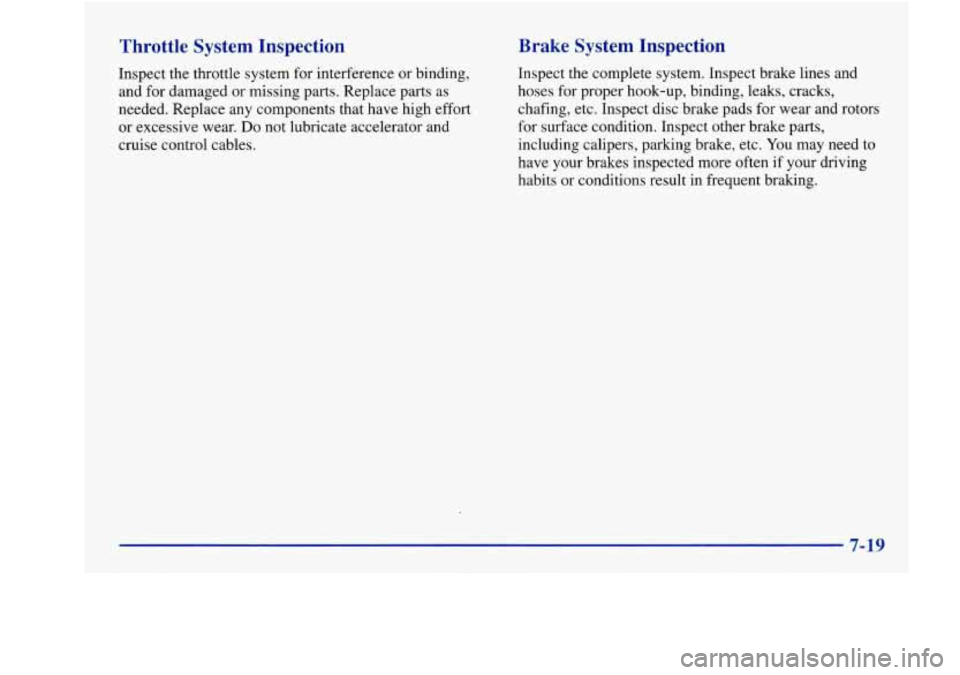
Throttle System Inspection
Inspect the throttle system for interference or binding,
and for damaged or missing parts. Replace parts as
needed. Replace any components that have high effort
or excessive wear. Do not lubricate accelerator and
cruise control cables.
Brake System Inspection
Inspect the complete system. Inspect brake lines ana
hoses for proper hook-up, binding, leaks, cracks,
chafing, etc. Inspect disc brake pads for wear and rotors
for surface condition. Inspect other brake parts, including calipers, parking brake, etc.
You may need to
have your brakes inspected more often if your driving
habits or conditions result in frequent braking.
7-19
-
Page 365 of 380
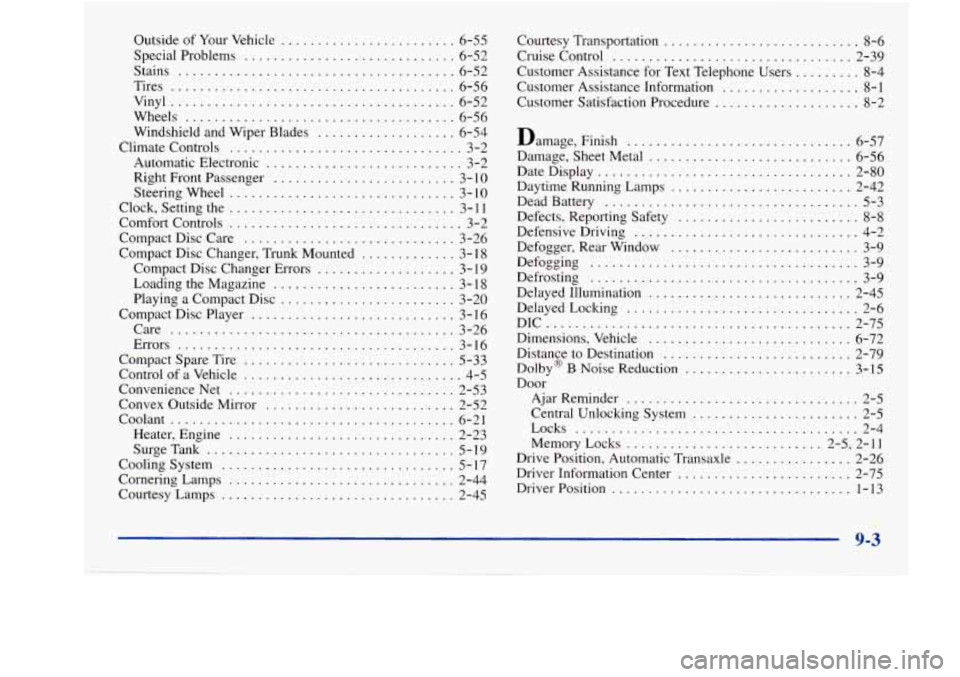
Outside of Your Vehicle ........................ 6-55
Special Problems
............................. 6-52
Stains
...................................... 6-52
Tires
....................................... 6-56
Vinyl
....................................... 6-52
Wheels
..................................... 6-56
Windshield and Wiper Blades
................... 6-54
Climate Controls
................................ 3-2
Automatic Electronic
........................... 3-2
Right Front Passenger
......................... 3- 10
SteeringWheel
............................... 3-10
Clock. Setting the
............................... 3- 11
Comfort Controls ................................ 3-2
Compact Disc Care
............................. 3-26
Compact Disc Changer. Trunk Mounted
............. 3- 18
Compact Disc Changer Errors
................... 3- 19
Loading the Magazine
......................... 3- 18
Playing a Compact Disc
........................ 3-20
Compact Disc Player
............................ 3-16
Care
....................................... 3-26
Errors
...................................... 3-1 6
Compact Spare Tire
............................. 5-33
Control of
a Vehicle .............................. 4-5
ConvenienceNet
............................... 2-53
Convex Outside Mirror
.......................... 2-52
Coolant
....................................... 6-21
Heater. Engine
............................... 2-23
SurgeTank
.................................. 5-19
Cooling System
................................ 5- 17
Cornering Lamps ............................... 2-44
Courtesy Lamps
................................ 2-45 Courtesy
Transportation
........................... 8-6
Cruise Control
................................. 2-39
Customer Assistance for Text Telephone Users
......... 8-4
Customer Assistance Information
................... 8-1
Customer Satisfaction Procedure .................... 8-2
Damage. Finish
............................... 6-57
Damage. Sheet Metal
............................ 6-56
DateDisplay
................................... 2-80
Daytime Running Lamps
......................... 2-42
Dead Battery
................................... 5-3
Defensive Driving
............................... 4-2
Defogger. Rear Window
.......................... 3-9
Defogging
..................................... 3-9
Defrosting
..................................... 3-9
Delayed Illumination
............................ 2-45
DelayedLocking
................................ 2-6
DIC
.......................................... 2-75
Dimensions. Vehicle
............................ 6-72
Distance to Destination
.......................... 2-79
Door Defects.
Reporting Safety
......................... 8-8
Dolby@ B Noise Reduction ....................... 3-15
Ajar Reminder
................................ 2-5
Central Unlocking System
....................... 2-5
Locks
....................................... 2-4
Memory Locks
........................... 2-5. 2-11
Drive Position. Automatic Transaxle
................ 2-26
Driver Information Center
........................ 2-75
DriverPosition
................................. 1-13
9-3